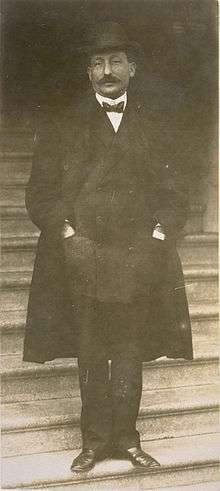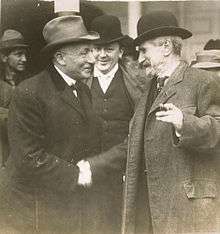Abe Ruef
| Abraham Ruef | |
|---|---|
 Political boss Abe Ruef | |
| Born |
September 2, 1864 San Francisco, California, United States |
| Died |
February 29, 1936 (aged 71) San Francisco, California, United States |
| Criminal charge | Bribery |
| Criminal penalty | 14 years |
Abraham Ruef (September 2, 1864 San Francisco, California – February 29, 1936 San Francisco), known as Abe Ruef, was an American lawyer and politician. He gained notoriety as the corrupt political boss behind the administration of Mayor Eugene Schmitz of San Francisco during the period before and after the 1906 San Francisco earthquake.
Education and influences
Born Abraham Rueff, his parents were from a French-Jewish background. Ruef was a very bright student and when barely fourteen, he began studying at the University of California, Berkeley, majoring in classical studies. While attending the university, he developed an interest in fighting the rampant corruption that was endemic to local and national politics at the time. With some fellow students he formed the "Municipal Reform League." He corresponded with like-minded individuals across the nation, including a young New Yorker named Theodore Roosevelt. At 18, Ruef graduated with the highest honors, then proceeded to enroll at the Hastings College of Law in San Francisco. He graduated from Hastings less than three years later and was accepted to the California State Bar when he was 21, the minimum age of admittance.[1]
California was a center of corruption at the time, influenced by the Southern Pacific Railroad which controlled both political parties in the state. They and other well-funded interest groups and individuals used their economic power and influence to form trusts and monopolies that guaranteed them power. Many of these wealthy and powerful people lived in San Francisco, and when necessary could reinforce their hold on power through corrupt politicians and city bosses.[1]
Political role
Although Ruef was for a long time a Republican, he wanted more power and in 1901 was the driving force behind the foundation of the new Union Labor Party.[1] Using his position there, he maneuvered himself into a position of power.
Chooses San Francisco Mayor
Ruef selected the relative unknown president of the Musicians Union, Eugene Schmitz, a violinist and amateur composer, to run for Mayor on the Union Labor Party ticket. Schmitz had no scandals in his past, was a tall, handsome man, a commanding speaker, possessed a likeable nature, and was married with two children. Ruef hoped that Schmitz might be both electable and conducive to influence that might lead the way to the governorship later on.[1] Behind the scenes, Ruef wrote Schmitz' speeches, planned his public appearances, and effectively ran his campaign. Schmitz became "Ruef's puppet" and was elected Mayor in 1902.[1]
Controls city politics
Ruef's political machine gradually gained control of the Chief of Police, the Board of Supervisors, and several judges. But shortly after the 1905 election, his choice for District Attorney, William L. Langton, began enforcing vice laws, largely ignored until then. Ever since the gold rush of 1849, San Francisco had a reputation as an open town, and the Barbary Coast's notorious dance halls, brothels and barely concealed gambling dens attracted money and people from across the West.[1]
Reformers gained considerable sympathy and support from the general population, who were growing tired of illicit and immoral activity. Radical puritans like Anthony Comstock and prohibitionists were also slowly gaining influence.[1]
Political reformers, among whom Ruef had once belonged, had gradually become more powerful over the previous decade, Langton threw the power of his office behind attacks on the brothels and gambling halls supported by the reformers. The San Francisco newspaper "Bulletin" edited by Fremont Older backed Langton's actions, and the publisher persuaded millionaire Rudolph Spreckels to fund a Federal investigation into corruption at City Hall.
Earthquake and aftermath
The widespread devastation that followed the 1906 San Francisco earthquake briefly slowed the investigation. Ruef himself lost "nearly $750,000 (about $20,000,000 today) of his real estate holdings".[2]:195 Mayor Schmitz formed the extra-legal Committee of Fifty to expedite repairs, and Ruef was not invited, but he showed up anyway at Franklin Hall where the committee met.[3]
Since "there wasn't a desk in the hall for Ruef, he accepted an offer to share a corner of the Mayor's desk."[2]:196 He became chairman of the Subcommittee on Relocating the Chinese and told the other members that "the Chinese must not be allowed to return to the desirable area that Chinatown occupied."[2]:236 The subcommittee debated the question without arriving at a consensus as to where relocate them. Meanwhile, the Chinese residents returned to Chinatown.
Indictment and conviction

On December 6, 1906, Ruef and Schmitz were arraigned in court. "As the indictments were read out by the clerk, Ruef made clear his disdain for the proceedings by standing with his back to the judge." At the time of his trial, Ruef occupied offices in The Columbus Tower, in North Beach.[2]:253 In February 1907 Ruef pleaded not guilty. On March 18, 1907, all of the Supervisors confessed before a grand jury to "receiving money from Ruef in connection with the Home Telephone, overhead trolley, prize fight monopoly, and gas rates deals.[2]:254 In exchange, "they were promised complete immunity and would not be forced to resign their offices. The grand jury then returned 65 indictments against Ruef for bribery of the supervisors."[2]:254
After the Supervisors' admissions, Ruef reached an agreement with the prosecution that he'd confess and receive immunity from most of the charges. On May 15, 1907, Ruef pleaded guilty and the next day testified before a grand jury, incriminating Schmitz. This led to Schmitz' conviction and removal from the Mayor's office on June 13, 1907. Ruef's trial ended on December 10, 1908, with a verdict of guilty and the maximum sentence for bribery—14 years in San Quentin. He spent a year at the county jail awaiting his appeal. In December 1909, he was released on bond of $600,000.[2]:256
Release from prison
In November 1910, his conviction and sentence were upheld. On March 1, 1911, he entered San Quentin Penitentiary. But the many businessmen and other politicians who benefited from the graft and corruption escaped punishment. Ruef was the only one jailed. Newspaper editor Older, formerly Ruef's most virulent opponent, became convinced that anti-semitism may have played a role in who was punished and who was not. Older corresponded with Ruef in prison and began to campaign through his newspaper for Ruef's release. Older felt that more of the individuals who took part in the corruption ought to be brought to justice. He paid Ruef over the next year to write a serialized account of his political career in the Bulletin, revealing the vast corruption underpinning the city.[1]
In 1912, Ruef was called as a witness at the new trial of ex-Mayor Schmitz, but he refused to testify. Later in 1912, Ruef wrote his memoirs which were published in the San Francisco Bulletin in almost daily installments over several months, finishing at the point where the graft investigation began. On August 23, 1915, having served a little more than four and a half of his fourteen-year sentence, he was released. He was not allowed to resume his legal practice. He had been worth over a million dollars before he went to prison, but died bankrupt.[2]:257
References
- 1 2 3 4 5 6 7 8 "Abe Ruef - America's Most Erudite City Boss". Virtual Museum of the City of San Francisco. Retrieved 31 May 2013.
- 1 2 3 4 5 6 7 8 Thomas, Gordon; Witts, Max Morgan (1971), The San Francisco Earthquake, New York, London: Stein and Day, Souvenir Press, Dell, ISBN 978-0-8128-1360-9
- ↑ Franklin Hall - Museum of the City of San Francisco Archived October 20, 2014, at the Wayback Machine.
Bibliography
- Thomas Lately. Debonair Scoundrel: The Flamboyant Story of Abe Ruef and San Francisco's Infamous Era of Graft (NY, 1962)
- Walton Bean. Boss Ruef's San Francisco: The Story of the Union Labor Party, Big Business, and the Graft Prosecution (Univ. of California Press, 1968)
- James P. Walsh. "Abe Ruef Was No Boss: Machine Politics, Reform, and San Francisco" (California Historical Quarterly, Spring 1972)
External links
| Wikisource has the text of a 1920 Encyclopedia Americana article about Abe Ruef. |
- SF Public Library—Historical Photographs
- Abe Ruef - America's Most Erudite City Boss Short biography
- Ruef and the ULP
- Photographs Related to the San Francisco Graft Trial, 1907-1908, The Bancroft Library